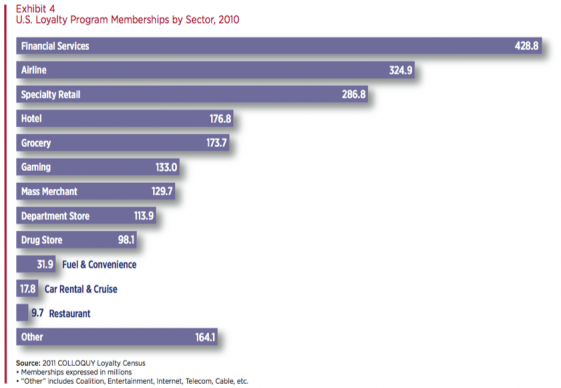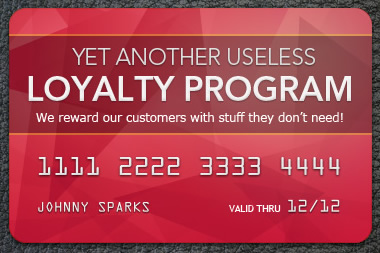Loyalty programs seem to be everywhere these days. From major airlines to local dry cleaners, it seems like wherever we go a company is offering us the option of joining their rewards program or loyalty club.
So what are these loyalty programs and, more importantly, how effective are they?
To my surprise, a good definition of loyalty program (LP) is hard to find. Considering the amount of focus and resources directed towards loyalty programs in modern business, one would think better definitions would be available. Below are the three best definitions I found, and ironically, none of them were from a “customer service” site:
Since the existing definitions are so weak and since I cannot very well have a post entitled “What Is a Loyalty Program” without defining the term, I decided to take a stab at creating a more comprehensive definition myself.
A new definition of loyalty program:
A loyalty program is a system of structured rewards given to customers, usually in exchange for desired behaviors, with the goals of increasing customer loyalty and collecting customer data. Loyalty programs use the psychological principles of reciprocity, commitment and loss aversion to increase the likelihood of customer loyalty.
As I offered in The Definition of Customer Loyalty, if anyone finds a better definition than the one above, please feel free to share it below in the comments.
Many readers might remember S&H Green Stamps as the primary rewards program of the pre-Internet era. I vividly remember getting those ever-familiar green stamps from the grocery store as a child and filling up those ridiculous books to get, well… stuff. However, though a rewards program, the S&H program was not truly an LP, since it stretched across retailers and was not exclusive to any one store or brand.
Modern loyalty programs are generally tied to specific brands, such as Starbucks Rewards, or groups of related brands such as Hilton Honors. As can be seen in the chart below, the prevalence of loyalty programs also varies greatly by industry.

Some of the most common rewards in modern loyalty programs are:
Despite some major commonalities, the list of reward types and program structures seems almost limitless in its variety. Accordingly, the efficacy of loyalty programs is inconsistent and leads to some interesting data.
Customer loyalty programs do not just seem ubiquitous, they are. According to the The Billion Member March: The 2011 COLLOQUY Loyalty Census (pdf), the average household is signed up for 18 loyalty programs, yet are active in only 8 of them.
The COLLOQUY study also notes the incredible value of loyalty programs and estimates the amount of rewards given or sold in 2011 to be $48 billion in the U.S. alone.
Some other statistics show how prevalent, how powerful, and how empty loyalty programs can be.
Source: CustomerThink
Source: Loyalty360
Source: NeoLane

If the above statistics prove anything, it is that an LP is not a guaranteed win for a company. Loyalty programs require time and capital to create and implement.
It is safe to assume that a successful loyalty program is created around rewards that consumers actually want and learning which rewards those are requires market research.
Setup and management of an LP can require increased staff and professional fees, items that might make the threshold for return on investment difficult to overcome.
Even with these numerous capital challenges, for the first time in history, small and medium-sized businesses have a chance to compete with the big boys. Technology has put loyalty programs within reach of smaller organizations, and big businesses have made loyalty programs so ubiquitous that small businesses can easily draft off of the inroads already made by the majors. If the average household is a member of 18 programs, the neighborhood yogurt shop should not have too much trouble convincing a family to make them #19.
Technology has kicked the hassle factor of loyalty programs in the teeth. Whereas previously large companies with their networked systems had a tremendous advantage over small business with their paper punch cards, technology has now leveled the playing field some. Services such as LoyalBlocks allow customers to put a digital “punch card” on their mobile phone, and small business credit card acceptance service Square just added a loyalty program to their service.
So, can a loyalty program benefit your business? While the devil truly is in the details on this question — dependent on industry, business model, and competitive landscape — here are three big picture concepts that you should consider before pursuing a program.
The reality is that, even when contracted through a third party, customer loyalty programs require an investment in labor and capital that is significant for almost any organization. And while these programs can be very effective, they are but one path to increasing customer loyalty.
Any business considering a loyalty program should not only consider the costs and benefits of the program but also the opportunity costs of company focus — focus that might be able to increase customer loyalty just as much if applied to Voice of Customer programs, Customer Experience Optimization, or just good, old-fashioned, kick-butt customer service.
Do you have a favorite loyalty program? Why do you like it and would you be as loyal to the company without it? Do you have programs you have signed up for that you have never used?
Comments have been closed on this post.
© 2011-2023 CTS Service Solutions, LLC.
All rights reserved.
Legal Information | Privacy Policy
How to Cite this Site
From a consumer’s standpoint, I love loyalty programs. We use them with the three different grocery stores we frequent (and our shopping for a given week is often dictated by the best rewards…often a discount on gas!), as well as CVS, and a few restaurants, coffee shops. For the coffee shops, there isn’t even much data collection: it’s a card that is punched or scanned, and over time, you end up with a free cup.
As I don’t travel much, I don’t use anything in terms of airline or hotel loyalty programs.
The key is to understand the total expense for the business, and make sure it makes sense for you.
But along the way, the more important factor to earning loyalty, is great customer service. If you combine that with a strong loyalty program, you can do really well.
I’m in a few programs, but I’ve never been very diligent about taking advantage of the rewards. You are smart to do so, as some programs can really save you $. Speaking of CVS, I once saw a thing online where someone had figured out a way to use the CVS program and coupons to pay almost nothing for items at CVS. Don’t remember much about it though.
I agree completely, from the business side, it really is about the total expense and the potential reward.
My mom is the queen of free at CVS. As a result, we will never run out of toothpaste. We have a closet full.
You should go on Disaster Preppers… 🙂
Pingback: Morning Announcements: Social Media Marketing Revelations, Inbound vs. Outbound Marketing & Creating a Loyalty Program That Works
Huh? Your definition looked like the other 3 all rolled into one………..
I think I’m quasi involved with 3 customer loyalty programs w/ CVS, Subway & Starbucks, but can tell you the ‘program’ is never my deciding factor whether I shop there or not.
You touch on some key points about differentiation, value and ROI. Why would somebody use it and does it really improve the bottom line by them doing so.
“Your definition looked like the other 3 all rolled into one…” And there, I thought I was being so original! 🙂
“Why would somebody use it and does it really improve the bottom line by them doing so.” We’ve both been around long enough to know how easily companies get caught up in the flavor of the month and adopt programs because they sound good not because they’ve thought through whether or not it will work with their model. It’s easy to say Company X has a loyalty program, so we should have one too.
If I already frequent the retailer or restaurant, I sign up for the loyalty program, and yes, I absolutely choose those establishments over others, so I can rack up points! Favorite restaurants: Gregg’s (see https://greggsusa.com/smart-diner) and Junction Trattoria. Favorite grocery store: Stop & Shop (gas points). Pet Supplies: Critter Hut. Office supplies: Staples. Other stores: CVS (ExtraBucks).
I love loyalty programs!
So far, we have 3 comments and 3 CVS program users — guess they are doing something right! We don’t have Gregg’s here, so thanks for sharing the link.
You embody exactly what most of these companies are shooting for with their programs. Repetitive business and loyalty because of the program!!! Win-win.
Pingback: Getting Over the Social Media Creep Factor
Although I have a loyalty program card at a grocery store, I rarely pay attention to what it offers me. I also have an air miles loyalty card that racks up points that I never seem to use. I’m the same way about coupons. I know they can really make a difference, but they bum me out. The thought of cutting them out, carrying them around, only to find out they’ve expired makes me wonder why I bother in the first place. Bottom line: I might sign up for a LP with a company I frequent, but it rarely seems to influence my purchasing decisions. Maybe I’m just with sucky loyalty programs, haha!
You and I are on the same page personally. I am terrible about keeping track of the points or even what programs I have. A long time ago, there was an airline program that inspired some loyalty due to points, but over time they watered down the rewards and value so much that when I did the math it almost never justified taking a higher price or being inconvenienced. For me it’s great products and great service that drive most of my loyalty.
Pingback: Monthly Mash: Customer Service Tools and Marketing in the Round
Pingback: Monthly Mash: Death of Newsweek & Preparing for Digital Change
you explain in detail of what is loyalty program is thanks for sharing such informative and useful tips for us to keep posting this type of article for us.
Our pleasure Maria! Glad you liked it.